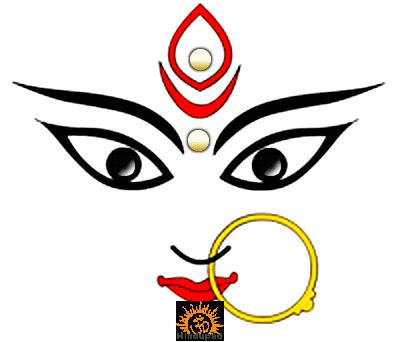The traditional way of reciting the “Devi Mahatmya” has been given below.
Obviously those who are not initiated are not required to follow it. They may just follow the remaining guidelines except for reciting the whole text in Sanskrit. They can just read the translation of the thirteen chapters without the navakshari japa, purvabhaga and uttara bhaga.
- The whole text has to be audibly recited. It should not be silently read.
- During the time of reading, one should not talk, think, sleep, sneeze, yawn or spit, but read with full concentration on The Devi.
- One should not stop in the middle of a chapter and the book should be placed on a stand, preferably a copper plate.
- At the beginning and end of each chapter, bells are to be rung.
- Before reciting the text, it is necessary to do the Sankalpa and Sri Devi Puja.
The place where the text is recited becomes flooded with waves of vibration, purifying the whole place, and invoking the presence of The Very Devi.
Though initially it is unconscious, through regular sadhana a conscious dialogue starts between The Goddess and the devotee.
Her Grace Protects the devotee and Guides him through his own prarabdha, Fulfilling the immediate wants in life as and when necessary and eventually the supreme goal of life.
The recitation should be in the following order:
- Kavacham
- Argala Stotra
- Keelakam
- Navakshari japam
- Ratri Suktam
- “Devi Mahatmyam”
- Navakshari mantra japam
- Devi Suktam
- Rahasya trayam
- Kshama Prarthana
The order of recitation is slightly different in different traditions. Moreover, the Devi Suktam and Ratri Suktam have alternate tantric/pauranic versions apart from the vedic suktas. Apart from regular recitation of the text there is another practice of following a fixed number of recitations by a Chandi Homam.
Like any other ritual this will require trained priests to conduct it.
For instance during the Sata Chandi Yajnam, the first four days are devoted for 100 Chandi Parayana by ten priests as per the following schedule, followed by Chandi Homam on the final day.
| Day | Parayana | Navakshari Japa |
| 1 | Once | 4,000 |
| 2 | Twice | 3,000 |
| 3 | Thrice | 2,000 |
| 4 | Four times | 1,000 |
| 5 | Chandi Homan | |
| Total/ Priest | 10 times | 10,000 |
| Grand Total | 100 times | 100,000 |


